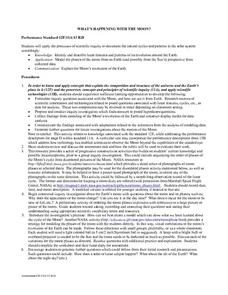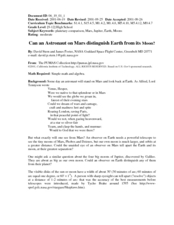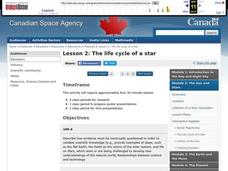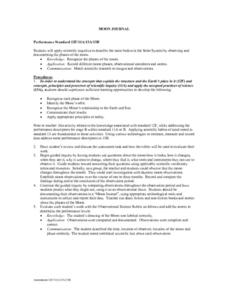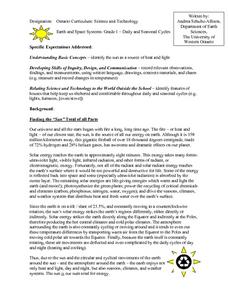Curated OER
Student Exploration: Phases of the Moon
In this moon phase worksheet, students complete 2 prior knowledge questions, then use the "Phase of the Moon Gizmo" to complete several activities, answering short answer questions when finished.
Curated OER
Phases of the Moon: Cooperative Learning
Third graders examine the phases of the moon. In this moon phase lesson, 3rd graders listen to a read aloud of The Moon Seems to Change by Franklyn M. Branley and discuss the phases of the moon. They complete a moon phase calendar and...
Curated OER
What's Happening With the Moon?
High schoolers review the process of scientific inquiry. Using this information, they identify the patterns and cycles of the moon as it revolves around the Earth. In groups, they model the phases of the moon from the Earth and Sun's...
Curated OER
Working on the Moon
Students take a mission to the moon. In this space science lesson, students visit selected websites to discover information about Earth's moon and the solar system. Students may take virtual missions to the moon and share...
Curated OER
Can an Astronaut on Mars Distinguish Earth from its Moon?
Students explore the possibility of being on Mars and being able to identify the Earth. In this space instructional activity students complete a set of calculations to see if this is possible.
Curated OER
Lunar Learning
Students learn about the phases of the moon. In this moon phases lesson plan, students learn about what causes the moon to look different to us everyday and how the Earth and Sun's position determine what phase the moon is in.
Denver Art Museum
Alien Beauty
"Beauty is in the eye of the beholder," is a popular phrase in our society. The lesson plan here puts the phrase to the test as pupils explore what truly is beautiful through a study of some Japanese folk art. A careful examination of...
NASA
Evaluating a Lunar Eclipse
Do all lunar eclipses look the same? Find out in an activity where astronomers use the Danjon Scale of Lunar Eclipse Brightness to describe the color and brightness of the moon during an eclipse. Explorers make three observations using...
Curated OER
Moon Phases
Students model moon phases and observe how it changes. In this investigative lesson students use a model to demonstrate the different phases of the moon.
Curated OER
Charting the Moon
Sixth graders observe changes in the moon's appearance over a month and keep records of their observations. They write a plan for recording what they see, and a paragraph reflecting on what they have learned over the course of the month.
Curated OER
Tides & Lunar Cycles
Students demonstrate how the moon affects the tides, a neap tide, and spring tides by using their bodies as models. After students observe the model they created, they draw and label the diagram on a provided worksheet. They then log...
Curated OER
The Life Cycle of a Star
Students investigate the life cycle of a star and make conclusions based on evidence, research, and observation. For this lesson on space and scientific investigation, students describe the relationships between science and...
Curated OER
Moon Journal
Fourth graders observe Moon and its features, and record results both in written form and in a drawing on the given template.
Curated OER
Multicultural Sun, Moon, and Star Activities
Learners research the multicultural stories and artistic representations of the Sun, Moon, and stars. In this multicultural space lesson plan, students discuss the symbols and stories for the sun in various cultures. Learners...
Curated OER
Lunar Lollipops
Students simulate the phases of the moon using a lamp and styrofoam balls. In this lunar phases lesson, students stand around a lamp and act as Earth. They hold styrofoam balls and rotate to show the phases of the moon.
Curated OER
The Reasons for the Season
Students explain the reason for the changes in season. In this instructional activity examining the relationship between the Earth and the Sun, students use an applet to discover how the alignment of the Earth and the Sun cause the...
Curated OER
Lunar Cycle
Young scholars recognize that the eight phases of the moon repeat. In this lunar cycle lesson, students experiment to understand the phases of the moon. Young scholars make observations and complete a "the Moon I See" worksheet. ...
Alabama Learning Exchange
The Solar System
Students explore the Solar System. In this cross-curriculum space instructional activity, students identify the planets, name them in order according to distance from the sun, and describe major characteristics of each planet. Students...
Curated OER
Daily and Seasonal Cycles
First graders identify the sun as a source of heat and light. They identify features of houses that help keep use sheltered and comfortable throughout daily and seasonal cycles. Students are told that summer is the best season to...
Curated OER
Wax On, Wane Off
Students explore the Earth's only natural sattelite, the moon. They view a demonstration using tennis balls of the waxing crescent moon, waxing gibbous moon and a lunar eclipse.
Curated OER
Day and Night
Expand your third graders' universe with a science activity about Earth's rotation. They read a short explanation about the direction of sunlight, then draw an arrow to indicate which way the sun is pointed at an illustration of the...
Curated OER
Moon Journal
Middle schoolers review the planets and major moons in the Solar System. In groups, they research and describe the various phases of the moon. They record their observations of the moon phases over a specific period of time and use the...
Curated OER
Moon WebQuest
Third graders research basic information about the moon and identify the phases and order of the phases of the moon. They conduct Internet research, complete a moon WebQuest, and write a magazine article about the moon using their...
Curated OER
May Earth be Revolving around the Sun?
Ninth graders explore how Aristarchus used the position of the half-full Moon to estimate the distance to the Sun, and how he made a great error, but still figured out that the Sun is much larger than Earth.




